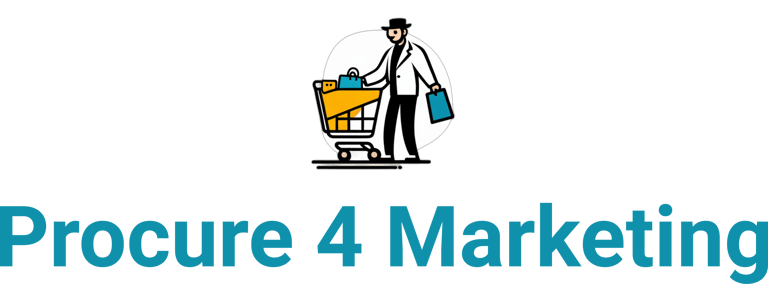How Can Procurement Strategies Enhance Marketing ROI?
Learn 5 key procurement strategies that can dramatically boost your marketing ROI, from strategic negotiation and supplier partnerships to leveraging data and technology.
MARKETING PROCUREMENT
The Procure 4 Marketing Team
11/3/20233 min read


Quick Answer: How can procurement increase marketing ROI?
Procurement can dramatically increase marketing ROI by moving beyond simple cost-cutting to become a strategic partner. The 5 key strategies to achieve this are: 1) Mastering Strategic Sourcing & Negotiation to lower campaign costs, 2) Building Collaborative Supplier Relationships to drive innovation, 3) Streamlining Processes with Technology to increase efficiency, 4) Using Data to Make Smarter Decisions, and 5) Mitigating Risk to prevent costly disruptions.
How Can Procurement Increase Marketing ROI?
In business, marketing creates the vision, but procurement ensures that vision is executed efficiently and effectively. An expert procurement strategy is the unsung hero behind a high-performing marketing ROI. By ensuring every dollar is spent intelligently, procurement doesn't just save money—it amplifies results. Let's explore the five key strategies that make this happen.
5 Key Procurement Strategies to Boost Marketing ROI
1. Master Strategic Sourcing & Negotiation
This is the most direct way procurement impacts ROI. It’s not about finding the cheapest supplier, but about sourcing the best value and negotiating terms that benefit the entire campaign.
How it Boosts ROI: Every dollar saved on inputs (like media buys, agency fees, or print materials) is a dollar that can be re-invested into other parts of the campaign to increase its reach and impact. Lowering the "I" (Investment) in the ROI calculation automatically increases the result.
Actionable Example: By negotiating a 15% volume discount on a year-long digital media buy, the procurement team saves $150,000. The marketing team can then reinvest that $150,000 into a new social media influencer campaign, generating an additional revenue stream.
2. Build Collaborative Supplier Relationships
Treating key suppliers like strategic partners rather than transactional vendors unlocks innovation and improves quality, leading to better marketing outcomes.
How it Boosts ROI: An innovative idea from a trusted agency partner can lead to a more effective campaign that generates higher revenue. Better quality from a print supplier can enhance brand perception. These improvements to the "R" (Return) side of the equation are invaluable.
Actionable Example: A creative agency, feeling like a trusted partner, proactively pitches a new interactive ad format. The campaign goes viral, generating double the expected leads and revenue compared to a standard campaign, dramatically increasing ROI.
3. Streamline Processes with Technology
Using technology to automate and simplify the procurement process reduces administrative overhead, minimizes errors, and speeds up campaign launches.
How it Boosts ROI: Reducing the "hidden costs" of manual labor, error correction, and project delays lowers the overall investment cost of a campaign. Faster speed-to-market also means you can capitalize on trends before competitors.
Actionable Example: By implementing an e-procurement platform, a company automates its purchase order and invoice process. This reduces the administrative time spent on each campaign by 20 hours, saving thousands in labor costs over a year and allowing the team to focus on more strategic work.
4. Use Data to Make Smarter Decisions
Leveraging data analytics allows procurement to identify spending inefficiencies and make informed decisions that optimize the marketing budget.
How it Boosts ROI: Data can reveal which investments are paying off and which are not, allowing you to double down on what works and cut what doesn't.
Actionable Example: By analyzing the last 12 months of spending, a data analyst in procurement discovers that the company is using five different video production agencies with overlapping costs. By consolidating the work with the top two performing agencies, they negotiate a 20% discount and improve the consistency of the final product.
5. Mitigate Risk and Ensure Quality
A failed campaign due to a supplier issue is the ultimate ROI-killer. Procurement's role in vetting suppliers and creating strong contracts is a critical form of financial insurance.
How it Boosts ROI: Proactive risk management prevents costly problems, such as a campaign launch being delayed due to a supplier failing to deliver, or a lawsuit resulting from improper image rights in a contract. It protects the entire investment.
Actionable Example: The procurement team conducts due diligence on a new event management company, discovering they have a poor track record for on-time setup. They choose a more reliable, slightly more expensive alternative, which prevents a potential disaster at the company's most important product launch event of the year.
Frequently Asked Questions (FAQ)
Q1: What is Marketing ROI and how is it calculated?
Marketing ROI (Return on Investment) is a metric used to measure the profitability of a marketing campaign. The basic formula is: ((Sales Growth - Marketing Investment) / Marketing Investment) x 100. A positive ROI means the campaign generated more revenue than it cost.
Q2: Isn't procurement's focus on cost a threat to marketing's creativity?
It can be if procurement is purely transactional. However, a strategic procurement team understands that in marketing, the cheapest option is rarely the best. Their goal is to achieve the best value and to work collaboratively with marketing to find partners who are both cost-effective and highly creative.
Q3: What is the fastest way procurement can impact marketing ROI?
The fastest and most direct way is through cost savings via strategic sourcing and negotiation. Reducing the upfront investment cost of a campaign provides an immediate and measurable boost to the final ROI calculation.

